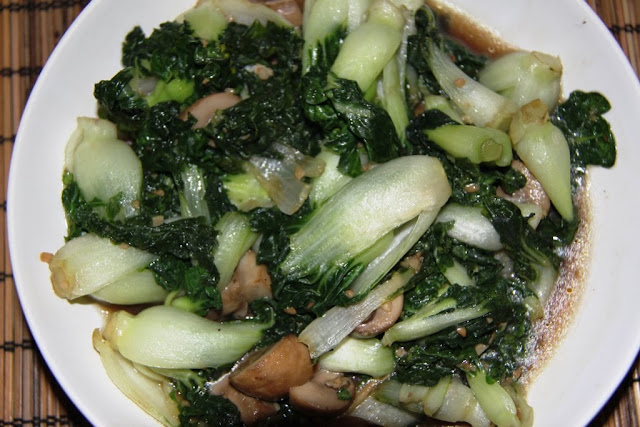Stir-fried baby lai pak with button mushrooms
Shopping at Fair Price Finest or Cold Storage here in Singapore, I get the dual sensation of feeling like on the one hand, I could be at any supermarket in the UK, and on the other, right in the heart of Southeast Asia. I've often been amazed at the sheer variety of vegetables that are available here in Singapore. The vast majority of food here, or over 90% is imported. I was talking to B the other day about how I was momentarily excited when I saw a bag of "Earthbound Organic" salad at the store. And then it (and its hefty price tag) hit me that while it was being sold as the environmentally benign choice for eco-aware consumers, in reality, that salad alone probably had chalked up a carbon footprint larger than all the local vegetables (heck, perhaps even combined with the fruit) on the shelves combined. According to one source, a bag of salad that is flown from Washington D.C. has traveled an estimated 9659 miles (15541km) to make it to your store in Singapore, emitting 3477 kgCO2 or 949 kg Carbon. Food for thought, indeed.
Chinatown, Singapore, 2010
With the expansion in the Chinese economy, there has been a large increase in the numbers and types of Asian greens from China. I do love my leafy greens, and one of the interesting trends these days is that you can find a "baby" or a miniature version of any vegetable at the market, for example baby kailan, baby bok choy, baby spinach, baby potato, baby carrot and so on. But what exactly are baby vegetables? More importantly, are they necessarily better both in terms of taste as well as nutrition? A cursory search on the internet reveals that they are not, as commonly perceived, necessarily vegetables that are picked before they are fully mature or ripe. Rather they are often specially engineered crops that are cultivated for a specific reason, for example, size. While they are almost always more expensive than their regular sized counterparts, nutritionally they are the same. I do admit that they are cute and also slightly more delicate in terms of taste and texture, but I find that the difference is minimal. So the jury's still out as far as I'm concerned. For me the far bigger question I suppose is where and how they were grown and harvested, and the times of pesticides and chemicals that were used on the farm.
If you're going to be cooking Asian food, learning the basics of the simple stir-fry is absolutely essential. (For more wok tips, see previous entry on Chinese fried rice). Yet many people have complained that their attempts at stir-frying vegetables have met with failure because the vegetables have either been undercooked or too wilted. So here I am sharing with you a basic recipe and a few tips on stir-frying greens that I learned from my mother and my own experience as a home chef. This recipe does not have a rich sauce or gravy such as you would find in the dish Broccoli with Oyster Sauce that is often served in Chinese restaurants, thus is best paired with a more substantial meat or saucy tofu dish.
Serves 2-3 as a side dish
1 bunch leafy vegetable such as kai lan, bok choy, mustard greens/sawi, siew pak choy, sweet potato leaves,Chinese cabbage, usually sold in bundles of about 300 g each
2-3 cloves garlic, peeled and smashed lightly
2 tbsp of vegetable oil such as olive or canola
1/4 cup light vegetable stock
1 tsp Chinese rice wine
1 tsp Chinese rice wine
1-2 tsp soy sauce
Dash sugar and pepper (optional)
Wash vegetables in a basin in several changes of water. Drain and keep aside. Heat wok over high heat. Add oil and swirl to coat. Add garlic and stir-fry briskly until fragrant. Working quickly, add vegetables, one handful at a time, and toss, waiting for each batch to wilt slightly before adding a new batch. Sprinkle a few drops of stock into the wok with each addition to maintain a steady heat. When all vegetables have been added, add remaining stock, rice wine, soy sauce and sugar and pepper if using and cover the wok with a lid. Lower the heat to medium and let the mixture simmer. Lift the cover of the wok after a minute or so, and stir everything around before returning the cover and simmering for another 2-3 minutes or until vegetables are just tender crisp. Remove from heat and serve immediately.
Tips:
- You can build upon this basic recipe by adding additional vegetables such as carrots, mushrooms, baby corn, snow peas - anything you like really. The trick is to ensure that you put in the vegetables that take the longest to cook first, and the leafy vegetables which only need a minute or so to wilt, last. For example, if you want to create a spinach mushroom stir-fry, you are going to need about 3-4 minutes for your mushrooms and under a minute for the spinach.
- You can substitute thinly sliced ginger for the garlic. Or use both.
- Many chefs like to use a little ikan bilis stock for frying vegetables.
- Use a wok for superior results and get it really hot before you add the vegetables. If the wok is not hot enough the vegetables will not only be oily but will steam, and you will not get the tender-crisp texture that you are looking for in a good stir-fry.
- One of the things that I learnt from my mother about estimating when the time is right to lift the wok cover and give the vegetables a quick stir. I've tried this method myself, and it's fairly accurate. When you cover the vegetables for the first time, place your bare hand on the handle of the wok. When it starts to feel a bit uncomfortable from the heat, lift up the cover and stir around! Repeat as necessary. Not recommended for the faint hearted.




































